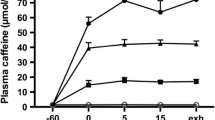Summary
The effect of hypothermia with and without ethanol on the myocardium and skeletal muscle was studied. Changes were observed in both muscle types. The mildest lesions were discoloration of the muscle cells with acid fuchsin and Heidenhain's iron haematoxylin staining, these being more marked in the skeletal muscle. Waving and contraction bands in the muscle were seen in hypothermia. The most severe lesion was a focus with oedema and haemorrhage, a reduced reaction ofβ-hydroxybutyrate dehydrogenase and fragmentation of the muscle cells, and this was more frequent in the myocardium. Occasionally discoloration, contraction bands and waving were also seen in the controls killed by a blow on the neck. The changes were more numerous in the guinea pigs given ethanol before cold exposure, and serum creatinine phosphokinase was elevated in the same group. Urinary excretion of adrenaline increased in cold exposure, but noradrenaline did not change significantly. Hypoxia, catecholamines, and sludging of the blood are discussed as possible aetiological factors for the lesions.
Zusammenfassung
Die Einwirkung von Hypothermie auf das Myokard und den Skelettmuskel sowie die Mitwirkung von äthylalkohol wurde an Meerschweinchen studiert. Veränderungen konnten in beiden Muskelgruppen festgestellt werden. Eine leichte Läsion der Muskelzellen zeichnete sich als Dyskolorierung mit der Acid-Fuchsin- und Heidenhains-Eisen-Haematoxylin-Färbung. Die Veränderungen waren ausgeprägter in der Skelettmuskulatur.
Die Hypothermie-Gruppe zeigte wellenförmige Deformation der Muskelfasern und sog. hyaline Querbänder. Die stärksten Veränderungen: ein Focus mit Oedem, Haemorrhagie, Fragmentierung der Muskelzellen sowie eine herabgesetzte Reaktion derβ-Hydroxy-Buttersäure-Dehydrogenase wurden häufiger im Myokard beobachtet. Gelegentlich sah man auch bei den Kontrolltieren, die durch einen Schlag in den Nacken getötet wurden, Dyskolorierung und wellenförmige Deformierung der Muskelfasern sowie hyaline Querbänder.
Die Veränderungen wurden häufiger bei denjenigen Meerschweinchen gesehen, die Alkohol vor der Kälteeinwirkung bekommen hatten. In derselben Gruppe waren auch die CPK-Werte im Serum erhöht. In der Kälte war die Urinexkretion von Adrenalin erhöht, dagegen beim Noradrenalin gab es keine statistisch signifikante Veränderung. Als mögliche ätiologische Faktoren der Läsionen werden Hypoxie, Katecholamine und Erythrozytenaggregation diskutiert.
Similar content being viewed by others
References
Barka T, Anderson PJ (1965) Oxidative enzymes. In: Histochemistry. Harper and Row, New York
Blair E, Hook R (1961) Serum glutamic oxalacetic transaminase content in hypothermia. Science 133:105–106
Duguid H, Simpson RG, Stowers JM (1961) Accidental hypothermia. Lancet 2:1213–1219
Duthie AM, White JF (1977) Cardiac arrest temperature: The effect of ethyl alcohol and carbon dioxide on rats, guinea pigs, and isolated rat hearts. Clin Exp Pharmacol Physiol 4:375–381
Fisher ER, Fedor EJ, Fisher B (1957) Pathologic and histologic chemical observations in experimental hypothermia. AMA Arch Surg 75:817–827
Gilmour RF, Mallow S (1977) Protective effect of ethanol against epinephrine-induced myocardial necrosis in rats. Res Comm Chém Pathol Pharmacol 18:303–327
Gopinath C, Thuring J, Zayed I (1978) Isoprenaline-induced myocardial necrosis in dogs. Br J Exp Pathol 59:148–157
Hirvonen J (1976) Necropsy findings in fatal hypothermia cases. Forensic Sci 8:155–164
Kreinsen U, Bilsing CM (1975) Experimentelle Herzmuskelnekrosen bei der Ratte nach Gabe von 1-Noradrenalin und Strophanthin. Virch Arch A, Pathol Anat and Histol 367:47–57
Lie JT, Holley KE, Kampa WR, Titus JL (1971) New histochemical method for morphologic diagnosis of early stages of myocardial ischemia. Mayo Clin Proc 46:319–327
Lillie RD (1965) Histopathologic technic and practical histochemistry, 3rd edn. McGraw Hill, New York
Löfgren L (1961) Histochemical investigation of succinic dehydrogenase in experimental hypothermia and parallel histo-pathological observations. Acta Pathol Scand 51:331–341
Maclean D, Griffiths PD, Emslie-Smith D (1968) Serum enzymes in relation to electrocardiographic changes in accidental hypothermia. Lancet Dec 14:1266–1270
MacGregor DC, Armour JA, Goldman BS, Bigelow WG (1966) The effects of ether, ethanol, propanol, and butanol on tolerance to deep hypothermia. Dis Chest 50:523–529
Pekkarinen A (1969) Fluorometric determination of adrenaline and noradrenaline. In: Manninen K (ed) (doctoral thesis) Regulation of the increased adrenomedullary secretion by drugs. Jaakkoo-Taara, Turku, pp 1–147
Poley RW, Fobes CD, Hall MJ (1964) Fuchsinophilia in early myocardial infarction. Arch Pathol 77:325–329
Regan TJ, Koroxenidis G, Moschos CB, Oldewurtel HA, Lehan PH, Hellems HK (1966) The acute metabolic and hemodynamic responses of the left ventricle to ethanol. J Clin Invest 45:270–280
Romeis B (1968) Mikroskopische Technik. Oldenburg, München
Sano ME, Smith LW (1940) A critical histopathologic study. Fifty post-mortem patients with cancer subjected to local or generalized refrigeration compared to a similar control group of 37 nonrefrigerated patients. J Lab Clin Med 26:443–456
Sarajas HSS (1964) Myocardial damage induced by immersion hypothermia. Am J Cardiol 13:355–366
Sarajas HSS (1961) Heart damage in dogs subjected to hypothermia, with or without complicating cardiac operations. Ann Acad Sci, Fenn A, Helsinki
Smith LW (1940) Pathologic changes observed in human tissues subjected to subcritical temperatures. Arch Pathol 30:425–439
Webb WR, Harrison N, Dodds R, Wax SD, Sugg WL (1968) Protective effect of ethyl alcohol in profound hypothermia. Cryobiology 4:290–294
Author information
Authors and Affiliations
Rights and permissions
About this article
Cite this article
Hirvonen, J., Penttinen, J., Huttunen, P. et al. Changes in the myocardium and skeletal muscle in guinea pigs in cold exposure with and without ethanol. Z Rechtsmed 84, 195–207 (1980). https://doi.org/10.1007/BF01866571
Received:
Issue Date:
DOI: https://doi.org/10.1007/BF01866571




